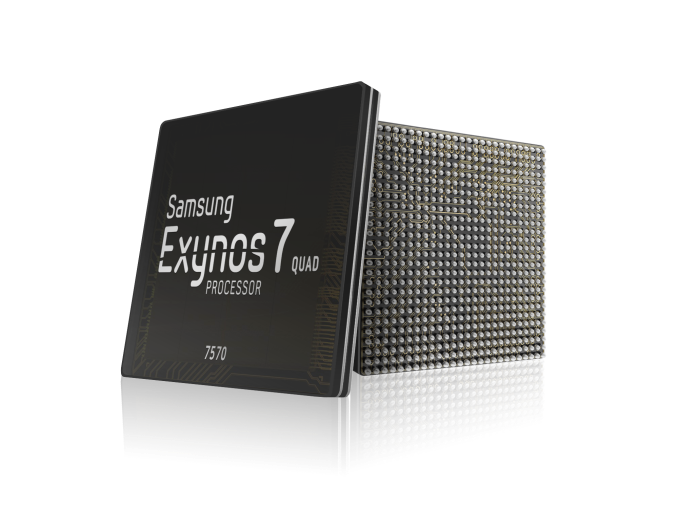Samsung Announces Exynos 7570 14nm Budget SoC
by Andrei Frumusanu on August 30, 2016 6:00 AM EST
Today Samsung LSI launches a new 14nm SoC oriented at the budget and IoT segments. The new Exynos 7570 seems to be a a successor to the Exynos 3470 and Exynos 3475 found in a few of Samsung's budget lineups such as the Galaxy S5 Mini. The chip is a quad-core A53 setup which is said to improve performance by 70% and power efficiency by 30% over its predecessor, although exact clocks weren't publicized. Equally not specified was the GPU, although because of the advertised maximum 1280x800 resolution capabilities of the display pipeline, I wouldn't expect anything more than a very small implementation of a low-end Mali series.
The more interesting aspects of this new SoC is its connectivity features as not only does it feature an integrated UE Category 4 modem with 2x carrier aggregation capabilities, but it also as far as I know for the first time for S.LSI integrates WiFi, Bluetooth, FM and GNSS capabilities, features that have traditionally been left in the charge of dedicated solutions such as Broadcom WiFi SoCs (Which following the acquisition by Avago have exited that business segment).
| SoC | Exynos 7570 | Exynos 7580 | Exynos 7870 |
| CPU | 4x A53 @ ?GHz | 8x A53 @ 1.6GHz | 8x A53 @ 1.6GHz |
| GPU | ? | Mali T720MP3 @ 600MHz |
Mali T830MP2 @ 700MHz |
| Encode/ Decode |
1080p60 H.264 |
||
| Camera/ISP | Dual ISP 21MP / (13+8) |
Dual ISP 16MP / (8+8) |
Dual ISP 16MP / (8+8) |
| Integrated Modem |
Cat. 4 150Mbps DL 2x20MHz C.A. |
Cat. 6 300Mbps DL 2x20MHz C.A. |
Cat. 6 300Mbps DL 2x20MHz C.A. |
| Connectivity | WiFi, BT, FM, GNSS |
N/A | |
| Mfc. Process | 14nm | 28nm HKMG | 14nm |
Earlier this year we were surprised to see Samsung announce a 14nm mid-range product as we weren't expecting the economics of the new FinFET manufacturing processes to work out for anything other than flagships SoCs, but soon after Qualcomm followed suit with their own 14nm mid-range SoC. Today's announcement seems to further dispell the doom & gloom over FinFET manufacturing cost as the Exynos 7570's stictly low-end and IoT orientation makes it the first budget SoC on the new process and something as I see as a positive development as the industry continues to shift to full FinFET lineups.
Source: Samsung Newsroom










17 Comments
View All Comments
Chaitanya - Tuesday, August 30, 2016 - link
Looks like this might compete with the Snapdragon 410 in product stack.R0H1T - Tuesday, August 30, 2016 - link
@Chaitanya Most likely it'll compete with the SD625 & Mediatek P20, especially if the GPU is fairly competent. The SD410 & other 4xx are not in the same class, it also doesn't help that they're on an inferior 28nm prcoess.mczak - Tuesday, August 30, 2016 - link
This very much competes with SD 4xx imho (the 7870 is already strictly inferior to the SD 625).You are however right this should outclass the SD 410. But the SD 430/435 (which both have 8 A53 cores too and much faster gpus than the SD 410) should be quite decent competitors, albeit you are correct the 7570 might have some advantage (especially wrt power consumption) due to 14nm manufacturing.
Morawka - Tuesday, August 30, 2016 - link
i dont know about the power consumption.. all signs point to samsung's 14nm being power hungery. see RX480, or Apple A9. Definitely not as good as tsmc 16nm in power and thermalsMrSpadge - Wednesday, August 31, 2016 - link
The difference for A9 is relatively small and wouldn't matter for a low end SoC. Regarding the RX480: there's nothing to compare it too (to judge the process). It is less power efficient than Pascal for sure, but so were AMDs 28 nm TSMC chips compared to nVidias 28 nm TSMC chips.muddling - Friday, September 2, 2016 - link
No, SD410. Both are A53. SD625 is A57 (I think...) SD650 is A72.So right there, it is a SD410 competitor, not SD625.
The ISP matches up to the SD410.
The GPU distinctly lags. SD410 at 1920x1080 vs this at 1280x800.
So I think at best, it competes with the SD410, and likely lags on the graphics side.
Achtung_BG - Tuesday, August 30, 2016 - link
First mid range finfets SoC is Kirin 650.MrSpadge - Tuesday, August 30, 2016 - link
"Today's announcement seems to further dispell the doom & gloom over FinFET manufacturing cost"The cost per transistor may have gone up a little, but some of that could be counteracted by needing fewer of the higher performing transistors to reach a certain performance and power efficiency target.
Another problem with the newer nodes is increasing design complexity, increasing the cost per design. I can imagine Samsung to handle this well and with better tools than at older nodes, since they've already designed somewhat similar chips. There's got to be some synergies.
jjj - Tuesday, August 30, 2016 - link
This is a mistake ,they need Cat 7 even here and without that the value and usefulness is rather low.A5 - Tuesday, August 30, 2016 - link
Cat 4 can do 150/50.There is no current need for Cat 7 for an SoC that is designed for sub-$100 phones and IoT devices.